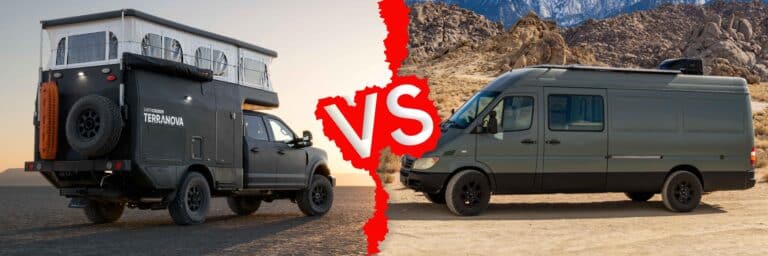One of the most frequent questions we’re asked is how to find places to camp outside of public campgrounds. Dispersed camping is often free in National Forests and on BLM land, typically restricted to 14 days at a time, but it’s not always simple or clear to find a spot on which to do so.
In this article we’ll cover how to find dispersed camping using these methods:
- Apps & Websites
- Accessible Private Land
- Digital & Physical Maps
- Forums & Social Media
- In Person
Apps & Websites
One of the quickest and easiest ways to find a site is via the plethora of websites and apps explicitly designed to help people find a place to camp. Most are free or available for a modest subscription, and many cover not only campsites but also resources like gas stations and places to refill your water tanks. While there is no doubt about their value, it’s important to keep in mind that the information on these platforms is typically crowd-sourced, meaning it relies on users to add places and information. The benefit to crowd-sourced information is that it’s updated frequently; the downside is that you’re relying on someone else’s standard of what a good or safe campsite is.
iOverlander
For years, iOverlander has been the leader in crowd-sourced camping information. It is the go-to resource for many for information on off-road dispersed camping, as well as important services like water filling stations and laundromats. As all its data is crowd-sourced, it’s important to carefully weigh dispersed camping reviews, noting how frequently and recently they’ve been updated – take any listing not frequently updated with a grain of salt. Its maps are not supported offline.
FreeCampsites.net
Another crowd-sourced directory of services and remote camping destinations, FreeCampsites.net has been around long enough to have an extensive list of sites and a wide community of users. Its interface feels a bit dated and clunky, but it has a loyal base of users. Its maps are not supported offline.
The Dyrt
The Dyrt is free to use for basic features, and full access is subscription-based. It’s a great resource for detailed descriptions, often with photographs of established campgrounds and extensive reviews. Its list of dispersed campsites is more limited but growing. You can download their maps for use offline.
Campendium
Started by a group of full-time Airstream owners, Campendium is free, but a subscription will eliminate ads on the site. It boasts a very active community of users contributing reviews and adding locations. Its user base tends to be mostly RV users, though its list of dispersed sites is extensive.
AllStays
The AllStays app is available for purchase for $9.99. Its strength is more in paid and established campsites than dispersed sites, but it does a good job of displaying helpful information like low vehicle clearances and services like water fill-ups and service centers (mostly for RVs). Its maps are not supported offline.
Private Land Camping
While you’ll typically have to pay to camp on private property, there are some distinct advantages to doing so. Landowners can limit the number of campers and ensure there is never overcrowding. They also set the rules, meaning they control things like fire bans, garbage disposal, and noise policies. Beyond just asking friends with property if they don’t mind you staying on their land for a few nights, a few companies act as online marketplaces for this service; think AirBnB for camping.
HipCamp
Hip Camp has no annual fee or membership requirements; simply search for a campsite via their app or website, filter by location and amenities, and make a booking just like you would a hotel. Some sites feature lush glamping tents and cabins, while others are as simple as a gravel parking pad. HipCamp is one of my favorite resources for finding camping just outside National Parks, where dispersed options are often slim or overused.
Harvest Hosts
For an annual fee, Harvest Host will connect you with business owners willing to rent out use of the property to overlanders and campers. The best locations are vineyards and scenic farms, which can make great overland boondocking sites. There are even a few museums that will allow overnight stays in the parking area. Some will even feature the option to learn about the places you’re staying, with farm tours, wine tasting, and volunteering opportunities. As a bonus, they’re often large enough to accommodate small groups. Local overlander meet-up, anyone?
Maps
While a map won’t tell you exactly where to disperse camp, a good one will offer enough clues to help you circle in on a 4×4 camping spot. Look for service roads through public lands and, if satellite imagery is available, look for obvious wide pull-offs or short trails that dead-end for potential overnight spaces. The best resources will include information from Motor Vehicle Use Maps (MVUM) from the USDA Forest Service, which helps detail which areas you can access.
OnX Offroad
The OnX Offroad app is targeted at overlanders. It includes helpful information such as the road closure dates, permits and fees required, and even trail ratings with the ability to set your route depending on what type of vehicles you’re driving (dirt bike/ATV vs. 4×4 vs. full-sized truck).
With a paid subscription to OnX, you’ll have access to public and private land boundaries. For additional land ownership information, you can subscribe to OnX Hunt, which is handy for accessing and camping in areas where public and private property are checkerboarded. Their maps can be downloaded and used offline.
Gaia
The basic Gaia app is free, but if you shell out for a Premium Membership, which also comes free with a subscription to Outside +, you’ll get access to the Gaia Overland layer. When selected, this layer will show in detail the surface of each road, a capability that most other apps lack. With this layer, you can route your trip to take in your preference of dirt, gravel, single, or double track roads. It also includes helpful information like open/closure dates and vehicle restrictions. Their maps can be downloaded and used offline.
Trailsoffroad
Trailsoffroad’s forte is in ratings and reviews of off-road driving trails, but it does have the option to filter by trails that have campsites. The app is free, but an All-Access Membership will get you access to its full library of trails. There is also a forum with a helpful community eager to answer questions about trails and ideas for places to camp. Their maps can be downloaded and used offline.
Google Earth & Google Maps
The standard in online maps and satellite imagery, Google is still an incredibly useful tool for the overlander. While it lacks some of the off-road-specific features of the other apps, the ease of use and worldwide coverage mean it remains the best choice for far-flung destinations. Sometimes, the resolution of their satellite images is good enough to zoom in on potential dispersed sites to see the telltale signs of previous campers, like fire rings.
Paper Maps
There’s still plenty of value in owning paper maps. Their sheer size can help clarify expansive regions and give you a clearer sense of perspective than on a screen. Plus, it’s often far easier to ask a local directions on a sheet of paper than through a phone screen. Benchmark Atlas and Maps are known for their detail and accuracy.
Web Forums, Social Media, & Facebook Groups
The overlanding community generally loves to share information and help out whenever possible. That said, there’s sometimes an understandable reluctance to post specific locations out of fear of overcrowding or misuse. Online forums like expeditionportal.com and overlandbound.com are full of helpful users, trip reports, and trail reviews. Most users are more than happy to answer requests for camping location recommendations and tips, particularly if politely requested via DM and with a promise to be a responsible overlander. There is also the overlanding subreddit and numerous Facebook groups.
The same can be said for YouTube, Instagram, and TikTok. With a bit of detective work, you can make out the general location of bushcamps or at least enough information to get you on the right road. From there, take it to a mapping app or Google Maps and zoom in on spots in the road where the trail widens or dead ends.
In Person
I’ve found no better resource for finding great dispersed camping sites than via the wonderful men and women who work for our public lands. Rangers and park managers are outdoor lovers by nature and a polite conversation with one of them can yield some of the best places to explore. Call up the regional ranger office or swing by their office. Most are happy to chat, go over the rules for camping in their jurisdiction with you, and maybe share a few hidden gems. Not only will you frequently get directions to some of the most beautiful, dispersed sites available, but rangers know local road conditions and weather forecasts, meaning they’re one of the best resources you can find to tell you if you’ll be able to access particular sites with your rig.
A few other helpful people to hit up are local guides and outfitters. The flyfishing guide who helped you land your first Steelhead knows every back road and bend in the river, and so long as he trusts you’ll leave no trace, they might be willing to share a few spots to camp. When booking local guides, I’ll often mention that I plan to camp in the area and am open to suggestions for roads to explore.
Get Lost
Finally, sometimes, half the fun of overlanding is not planning much at all. If you aren’t pressed for time, there can be no better feeling than simply turning onto a dirt road just to see where it goes.










